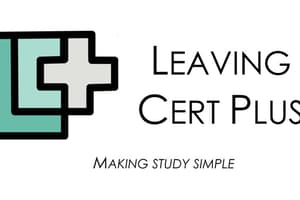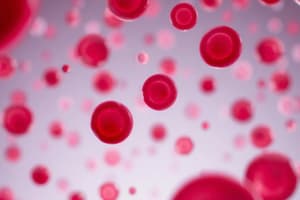Podcast
Questions and Answers
What is the primary function of red blood cells?
What is the primary function of red blood cells?
- Transport oxygen and carbon dioxide (correct)
- Transport hormones
- Fight infections
- Initiate blood clotting
Which type of white blood cell is primarily responsible for producing antibodies?
Which type of white blood cell is primarily responsible for producing antibodies?
- Basophils
- T cells
- Neutrophils
- B cells (correct)
What is the lifespan of platelets in the human body?
What is the lifespan of platelets in the human body?
- About 15 days
- Approximately 3 weeks
- Around 7 to 10 days (correct)
- Approximately 30 days
Which component of plasma is primarily responsible for maintaining blood pressure and volume?
Which component of plasma is primarily responsible for maintaining blood pressure and volume?
What is the first stage of the blood clotting mechanism?
What is the first stage of the blood clotting mechanism?
Which white blood cell type is most abundant and responds quickly to infection?
Which white blood cell type is most abundant and responds quickly to infection?
What happens to platelets upon activation at the site of an injury?
What happens to platelets upon activation at the site of an injury?
Which of the following is a function of plasma?
Which of the following is a function of plasma?
What is the role of anticoagulants in the blood clotting process?
What is the role of anticoagulants in the blood clotting process?
What transformation occurs during the coagulation stage of blood clotting?
What transformation occurs during the coagulation stage of blood clotting?
Flashcards are hidden until you start studying
Study Notes
Blood and Its Components
Red Blood Cells (Erythrocytes)
- Function: Transport oxygen from lungs to body tissues and carbon dioxide from tissues back to lungs.
- Structure: Biconcave disc shape increases surface area for gas exchange; lack a nucleus and organelles.
- Lifespan: Approximately 120 days; produced in bone marrow.
- Hemoglobin: Iron-containing protein that binds oxygen; gives blood its red color.
White Blood Cells (Leukocytes)
- Function: Part of the immune system; defend against infections and foreign substances.
- Types:
- Neutrophils: Most abundant; respond quickly to infection.
- Lymphocytes: B cells (produce antibodies) and T cells (kill infected cells).
- Monocytes: Differentiate into macrophages and dendritic cells; involved in phagocytosis.
- Eosinophils: Combat multicellular parasites and involved in allergic responses.
- Basophils: Release histamine during allergic reactions and inflammation.
- Lifespan: Varies from hours to years depending on the type.
Platelets (Thrombocytes)
- Function: Essential for blood clotting; prevent excessive bleeding by forming plugs at injury sites.
- Origin: Derived from megakaryocytes in bone marrow.
- Lifespan: Approximately 7-10 days.
- Activation: Upon injury, platelets become activated, change shape, and release chemical signals to recruit more platelets.
Plasma Functions
- Composition: 90% water, with proteins (albumin, globulins, fibrinogen), electrolytes, nutrients, hormones, and waste products.
- Functions:
- Transports nutrients, hormones, and proteins to cells.
- Maintains blood pressure and volume.
- Regulates body temperature and pH balance.
- Contains antibodies for immune response.
Blood Clotting Mechanisms
- Stages:
- Vascular Spasm: Blood vessels constrict to reduce blood flow.
- Platelet Plug Formation: Platelets adhere to the site of injury and aggregate, forming a temporary plug.
- Coagulation: Series of biochemical reactions lead to the transformation of fibrinogen into fibrin, creating a stable clot.
- Coagulation Cascade: Involves intrinsic (damage to blood vessels) and extrinsic (tissue factor exposure) pathways; both converge on a common pathway that leads to fibrin formation.
- Anticoagulants: Substances that prevent or reduce clotting; examples include antithrombin and proteins C and S.
- Fibrinolysis: The process of breaking down the clot after healing has occurred.
Red Blood Cells (Erythrocytes)
- Transport oxygen from lungs to body tissues and return carbon dioxide to lungs.
- Biconcave disc shape enhances surface area for efficient gas exchange; do not have a nucleus or organelles.
- Lifespan of approximately 120 days; produced in bone marrow.
- Hemoglobin, an iron-containing protein, binds oxygen and imparts the red color to blood.
White Blood Cells (Leukocytes)
- Integral to the immune system, aiding in defense against infections and foreign invaders.
- Neutrophils are the most abundant type and react rapidly to infections.
- Lymphocytes include B cells (produce antibodies) and T cells (eliminate infected cells).
- Monocytes evolve into macrophages and dendritic cells, playing a crucial role in phagocytosis.
- Eosinophils target multicellular parasites and are involved in allergic responses.
- Basophils release histamine during allergic reactions and inflammatory responses.
- Lifespans of leukocytes vary significantly, ranging from hours to years depending on type.
Platelets (Thrombocytes)
- Key players in blood clotting, preventing excessive bleeding through plug formation at injury sites.
- Generated from megakaryocytes in bone marrow.
- Platelets have a lifespan of around 7-10 days.
- Upon injury, they activate, change shape, and release chemical signals to attract additional platelets.
Plasma Functions
- Composed of 90% water, containing proteins (albumin, globulins, fibrinogen), electrolytes, nutrients, hormones, and waste.
- Transports essential nutrients, hormones, and proteins to various body cells.
- Maintains blood pressure and volume, regulating body temperature and pH balance.
- Contains antibodies that play a crucial role in immune responses.
Blood Clotting Mechanisms
- Vascular Spasm: Blood vessels constrict to minimize blood loss.
- Platelet Plug Formation: Platelets adhere to damage sites, aggregating to form a temporary plug.
- Coagulation: Biochemical reactions convert fibrinogen into fibrin, stabilizing the clot.
- Coagulation cascade includes intrinsic (due to blood vessel damage) and extrinsic (exposure of tissue factor) pathways, which converge on a common pathway for fibrin production.
- Anticoagulants: Substances like antithrombin and proteins C and S prevent excessive clotting.
- Fibrinolysis: The process that degrades clots after healing has occurred.
Studying That Suits You
Use AI to generate personalized quizzes and flashcards to suit your learning preferences.




